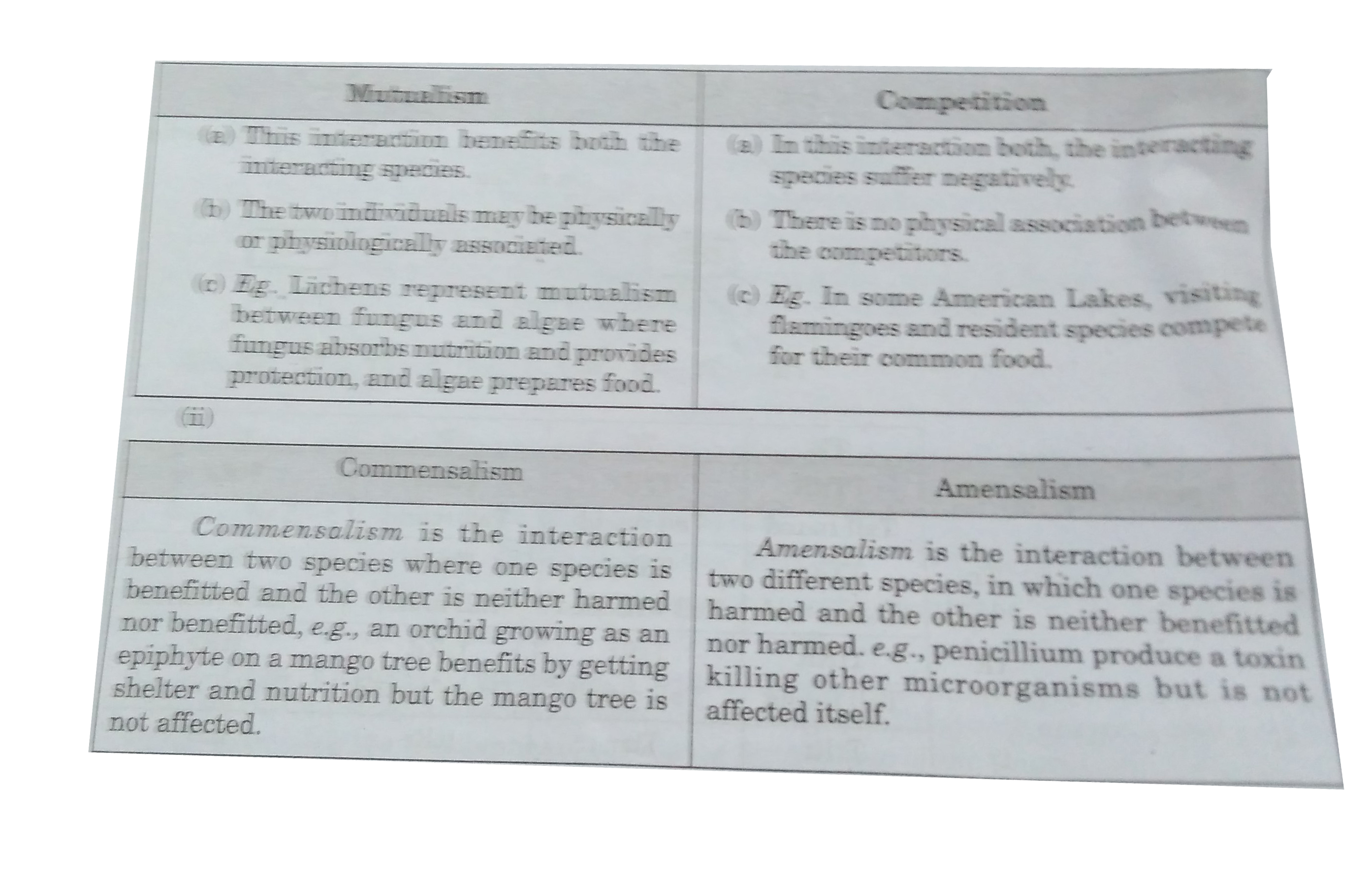(a) Why are herbivores considered similar to predators in the ecological context ? Explain.
(b) Differentiate between the following interspecific interactions in a population :
(i) Mutualism and Competition.
(ii) Commensalism and Amensalism.
(a) For a predator most probably it is tiger and the deer that readily come to our mind, but a sparrow eating any seed is no less a predator. Although animals eating plants are separately as herbivores, they are in a broad ecological context, not very different from predators.
Besides acting as "conduits" for energy transfer across trophic levels, predators, play other important roles.
They keep prey populations under control.
(b)

Topper's Solved these Questions
- XII BOARDSBook:XII BOARDS PREVIOUS YEARChapter:XII BOARDSExercise:SECTION -A
Explore 12 Videos
- XII BOARDSBook:XII BOARDS PREVIOUS YEARChapter:XII BOARDSExercise:SECTION -B
Explore 13 Videos
- XII BOARDSBook:XII BOARDS PREVIOUS YEARChapter:XII BOARDSExercise:SECTION-C
Explore 95 Videos
- SAMPLE PAPER 2019Book:XII BOARDS PREVIOUS YEARChapter:SAMPLE PAPER 2019Exercise:Section E Part B
Explore 3 Videos
Similar Questions
What of these interactions has negative effects ?
(i) Predation
(ii) Mutualism
(iii) Commensalism
(iv) Parasitism
View Solution(a) Why water soluble vitamins must be supplied regularly in the dite ? Give one example of it.
(b) Differentiate between the following :
(i) Essential and non-essential amino acids.
(ii) Fibrous and globular proteins.
View Solution
Knowledge Check
Refer to the given table that summarises the interactions between two organisms (organisms 1 and organism 2). Identify the types of interaction (A,B and C) and select the correct answer.

(i) A can be either predation or parasitism.
(ii) B can be either commensalism or amensalism.
(iii) C can beamensalism.
(iv) A can be amensalism.A(i) and (ii)B(ii) and (iii)C(iii) and (iv)D(i) and (iii)Which of the following pairs are correctly matched ?
1. Amensalism - A population is inhibited whereas the other populations remain unaffected.
2. Predation - A population uses the other as its food.
3. Mutualism - Interaction favourable to both and obligatory.
Select the correct answer using the codes given below : Answer codes :A1, 2 and 3B1 and 2C1 and 3D2 and 3
(a) Why is it that the father never passes on the gene for haemophilia to his sons? Explain.
(b) State the functions of the following in a prokaryote :
(i) tRNA, (ii) rRNA
View Solution(a) Why are haloarenes less reactive than haloalkanes? Explain.
(b) Predict the alkenes that would be formed by dehydrohalogenation of the following halides with sodium ethoxide in ethanol and predict the major alkene:
(i) 2-Chloro-2-methylbutane
(ii) 3-bromo-2, 2, 3-trimethylpentane
(c) How is chlorobenzene prepared from benzenediazonium chloride?
View Solution(a) Why are haloarenes less reactive than haloalkanes? Explain.
(b) Predict the alkenes that would be formed by dehydrohalogenation of the following halides with sodium ethoxide in ethanol and predict the major alkene:
(i) 2-Chloro-2-methylbutane
(ii) 3-bromo-2, 2, 3-trimethylpentane
(c) How is chlorobenzene prepared from benzenediazonium chloride?
View Solution(a) Members of second and third transition series exhibit similar atomic radii. Explain. (b) Account for the following: (i) Transition metals and their many compounds act as good catalysts. (ii) Actinoids has greater tendency to form complexes in comparison to Lanthanoids.
View SolutionDefine the following terms and give one example for each:
(a) Commensalism
(b) Parasitism
(c) Camouflage
(d) Mutualism
(e) Interspecific competition
View SolutionExplain the following: (i) Free entry and exist features of perfect comeptition, (ii) Differentiated product. Features of monopolist competition.
View Solution

